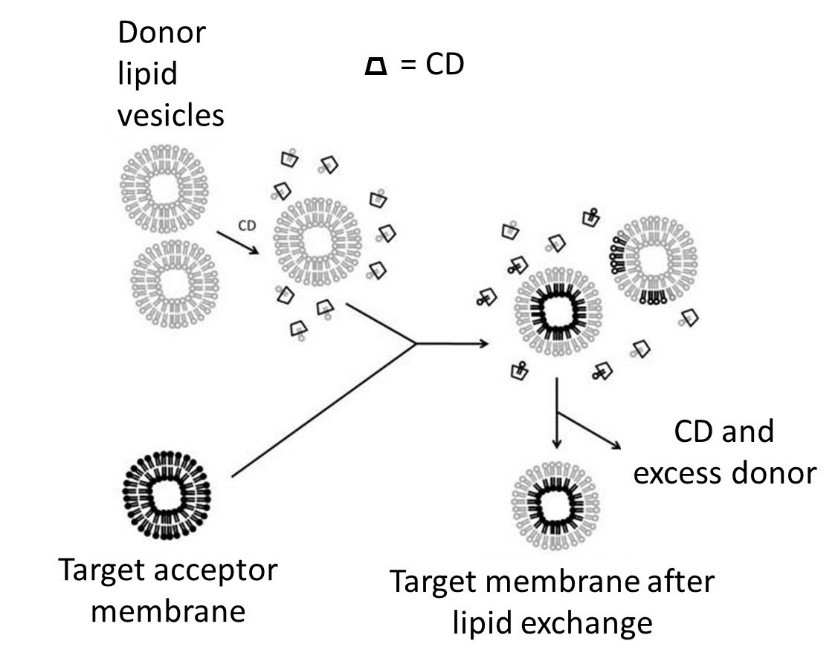
Erwin London
Distinguished Professor
Joint Appointment with Department of Biochemistry and Cell Biology
B.A., Queens College of the City University of New York, 1974
Ph.D., Cornell University, 1980
Postdoctoral Fellow, Massachusetts Institute of Technology
420 Life Science Building
Phone: (631) 632-8564
Email: erwin.london@stonybrook.edu
- Research Description
MEMBRANE PROTEIN AND LIPID BILAYER STRUCTURE AND ORGANIZATION
Our group is studying biomembrane structure and function by combining spectroscopic methods, especially fluorescence, with chemical, biochemical, cell biological and molecular biological approaches. In general, we are interested in determining how membranes are organized by lipid-lipid and lipid-protein interactions and how lipids influence membrane protein function.
Role of Sphingolipid-Cholesterol Lipid Domains (Rafts) in Membrane Organization and Its Influence Upon Membrane Protein Function
Highly ordered domains with tight lipid packing (rafts) are sphingolipid and cholesterol rich regions of biomembranes that contain a special subset of membrane proteins. Rafts have critical roles in a variety of signal transduction and pathological processes, including viral and bacterial infection. We have been studying the rules that govern raft formation and the association of particular lipids and proteins in rafts, and developing methods to modify raft properties. These experiments are carried out in artificial membranes (lipid vesicles, liposomes) as well as in living cells.
Lipid Exchange to Explore Biomembrane Organization and Membrane Protein Function
Natural membranes contain a bilayer of lipids that is often asymmetric, with different lipids in the inner and outer lipid monolayers. Our lab developed a breakthrough method for facile production of asymmetric membranes by lipid exchange using cyclodextrins (CD), water soluble cyclic glucose oligomers with a hydrophobic cavity that can accommodate the hydrocarbon chains of lipids. By carrying lipids between lipid vesicles with different lipid compositions, the desired asymmetric vesicle can be prepared (see Figure).

We have used this approach to study membrane domain formation in biologically relevant asymmetric artificial membranes, and to study whether asymmetric liposomes might have applications in drug delivery. Recently, the lab extended the method to living cells, allowing facile and wide-ranging manipulation of the lipids in the plasma membrane of cells for the first time. The method is being applied to understand how lipids control membrane protein function in living cells.
- Recent Publications
LeBarron, J., and London, E. (2016) “Effect of Lipid Composition and Amino Acid Sequence Upon Transmembrane Peptide-Accelerated Lipid Transleaflet Diffusion (Flip- Flop)” Biochim. Biophys. Acta 1858, 1812–1820.
Heberle, F.A., Marquardt, D., Doktorova, M., Geier, B., Standaert, R., Heftberger, P., Kollmitzer, B., Nickels, J.D., Feigenson, G.W., Katsaras, J., London, E., and Pabst, G. (2016) “Sub-nanometer Structure of an Asymmetric Model Membrane: Interleaflet Coupling Influences Domain Properties” Langmuir 32, 5195-5200.
Huang, Z., and London, E. (2016) “Cholesterol lipids and cholesterol-containing lipid rafts in bacteria” Chem. Phys. Lipids 199, 11-16.
London, E. (2016) “New Insights into How Cholesterol and Unsaturation Control Lipid Domain Formation” Biophys. J. 111, 465-466.
LeBarron, J., and London, E. (2016) “Highly Hydrophilic Segments Attached Hydrophobic Peptides Translocate Rapidly Across Membranes” Langmuir 32, 10752-10760.
Li, G., Kim, J., Huang, Z., St. Clair, J.R., Brown, D.A., and London, E. (2016) “Efficient Replacement of Plasma Membrane Outer Leaflet Phospholipids and Sphingolipids in Cells with Exogenous Lipids” Proc. Natl. Acad. Sci. USA 113, 14025-14030.
Huang, Z., Toledo, A.M., Benach, J.L., and London, E. (2016) “Ordered Membrane Domain Forming Properties of the Lipids of Borrelia burgdorferi” Biophys. J., 111, 2666–2675.
Zhang, X., St Clair, J.R., London, E., and Raleigh, D.P. (2017) “Islet Amyloid Polypeptide Membrane Interactions: Effects of Membrane Composition” Biochemistry, 56, 376-390.
Marquardt, D., Heberle, F.A., Miti, T., Eicher. B., London, E., Katsaras, J., and Pabst, G. (2017) “1H NMR Shows Phospholipid Flip-Flop in Vesicles is Extremely Slow in Both Gel and Fluid States” Langmuir 33, 3731–3741.
Kim, J., Singh, A., DelPoeta, M., Brown, D.A., and London, E. (2017) “The effect of sterol structure upon clathrin-mediated and clathrin-independent endocytosis” J. Cell Sci. 130, 2682-2695. Featured article in the “in this issue” section. *co-corresponding authors.
St. Clair, J.R., Wang, Q., Li, G., and London, E. (2017) “Preparation and Physical Properties of Asymmetric Model Membrane Vesicles” in “Springer Series in Biophysics: The Role of the Physical Properties of Membranes in Influencing Biological Phenomena” (Eds. R.M. Epand and J.M. Ruysschaert), Springer Nature Singapore, 1-27.
Farnoud, A.M., Raj, S., Kim J., Joffe, L., Zhang, X., Singh, A., Mor, V., Desmarini, D., Djordjevic, J., Raleigh, D.P., Rodrigues, M.L., London, E., and Del Poeta, M. (2017) “Changes in Glucosylceramide Structure Affect Virulence and Membrane Biophysical Properties of Cryptococcus neoformans” Biochim Biophys. Acta 1859, 2224-2233.
Toledo, A.M., Huang, Z., Benach J.L., and London, E. (2018) “Analysis of Lipids and Lipid Rafts in Borrelia” Methods Mol Biol. 1690, 69-82.
Kim, J., Fukuto, H.S., Bliska, J.B., Brown, D.A., and London, E. (2018) “Effects of host cell sterol composition upon internalization of Yersinia pseudotuberculosis and clustered beta-1 integrin” J. Biol. Chem. 293, 1466-1479.
Toledo, A., Huang, Z., Coleman, J.L., London, E., and Benach, J.L. (2018) “Lipid rafts can form in both the inner and outer membranes of Borrelia burgdorferi and have different properties and associated proteins” Mol. Microbiol. 108, 63-76.
Zhang, X., London, E., and Raleigh, D.P. (2018) “Sterol Structure Strongly Modulates Membrane-IAPP Interactions” Biochemistry 57, 1868-1879.
Wang, Q., and London, E. (2018), “Lipid Structure and Composition Control Consequences of Interleaflet Coupling in Asymmetric Vesicles” Biophys. J. 115, 664-678.
Doktorova, M., Heberle, F.A., Eicher, B., Standaert, R.F., Katsaras, J., London, E., Pabst, G., and Marquardt, D. (2018) “Preparation of asymmetric phospholipid vesicles: The next generation of cell membrane models” Nature Protocols 13, 2086-2101.
Delle Bovi, R.J., Kim, J., London, E., and Miller, W.T. (2019) “Sterol structure dependence of insulin receptor and insulin-like growth factor 1 receptor activation” Biochim. Biophys. Acta 1861, 819-826.
St. Clair, J.W., and London, E. (2019) “Effect of Sterol Structure on Ordered Membrane Domain (Raft) Stability in Symmetric and Asymmetric Vesicles” Biochim. Biophys. Acta 1861, 1112-1122.
Caputo, G.A., and London, E. (2019) “Analyzing transmembrane protein and hydrophobic helix topography by dual fluorescence quenching” in Methods in Molecular Biology series Volume 2003, Lipid-Protein Interactions: Methods and Protocols, Second Edition (Kleinschmidt, J.H. Ed.) Humana Press/Springer, New York, pp. 351-368.
London, E. (2019) “Formation and Properties of Asymmetric Lipid Vesicles Prepared Using Cyclodextrin-Catalyzed Lipid Exchange” in: The Characterization of Biological and Biomimetic Membranes: Structure and Dynamics. (Eds. M.-P. Nieh, F. A. Heberle and J. Katsaras) De Gruyter, Berlin, pp. 441-464.
Heerklotz, H., and London, E. (2019) “Kiss and run asymmetric vesicles to investigate coupling” Biophys. J. 117, 1009-1011.
London, E. (2019) “Membrane Structure-Function Insights From Asymmetric Lipid Vesicles” Acc. Chem. Res. 52, 2382-2391.
Huang, Z., Zhang, X., Blaser, M.J., and London, E. (2019) “Helicobacter pylori lipids can form ordered membrane domains (rafts)” Biochim. Biophys. Acta 1861, 183050.
Li, G., Kakuda, S., Suresh, P., Canals, D., Salamone, S., and London, E. (2019) “Replacing Plasma Membrane Outer Leaflet Lipids With Exogenous Lipid Without Damaging Membrane Integrity” PLoS ONE 14, e0223572. *equal contributions.
Li, G., Wang, Q., Kakuda, S., and London, E. (2020) “Nanodomains can persist at physiologic temperature in plasma membrane vesicles and be modulated by altering cell lipids.” J. Lipid Res. 61:758-766.
St. Clair, J.W., Kakuda, S. and London, E. (2020) “Induction of ordered lipid raft domain formation by loss of lipid asymmetry” Biophys. J. 119, 483-492.
Yano, Y., Hanashima, S., Tsuchikawa, H., Yasuda, T., Slotte, J.P., London, E. and Murata, M. (2020) “Sphingomyelins and ent-sphingomyelins form homophilic nanometer-sized subdomains within liquid ordered domains” Biophys. J. 119, 539-552.
Li, B., and London, E. (2020) “Preparation and Drug Entrapment Properties of Asymmetric Liposomes Containing Cationic and Anionic Lipids ” Langmuir 36, 12521-12531.
Kakuda, S., Li. B., and London, E. (2021) “Preparation and Utility of Asymmetric Lipid Vesicles for Studies of Perfringolysin O-Lipid Interactions” Methods Enzymol. 649, 253-276.
Li, M.-H., Manathunga, L. London, E., and Raleigh D.P. (2021) “The Fluorescent Dye 1,6-Diphenyl-1,3,5-Hexatriene Binds to Amyloid Fibrils Formed by Human Amylin and Provides a New Probe of Amylin Amyloid Kinetics” Biochemistry, 60, 1964-1970.
Suresh, P., Miller, W.T., and London, E. (2021) Phospholipid exchange shows insulin receptor activity is supported by both the propensity to form wide bilayers and ordered domains (rafts) J. Biol. Chem. 297:101010.
Li., M.-H., Raleigh, D.P., and London, E. (2021) “Preparation of Asymmetric Vesicles with Trapped CsCl Avoids Osmotic Imbalance, Non-Physiological External Solutions, and Minimizes Leakage” Langmuir 37, 11611-11617 *co-corresponding authors.
Suresh, P., and London, E. (2021) “Using cyclodextrin-induced lipid substitution to study the structure and function of ordered membrane domains (rafts) in cells.” Biochim. Biophys. Acta, 1864, 183774.
- Awards & Honors
Schroepfer Medal for advances in steroid or sterol field, American Oil Chemists Society
Fellow of the American Association for the Advancement of Science (AAAS)
SUNY Distinguished Professor
